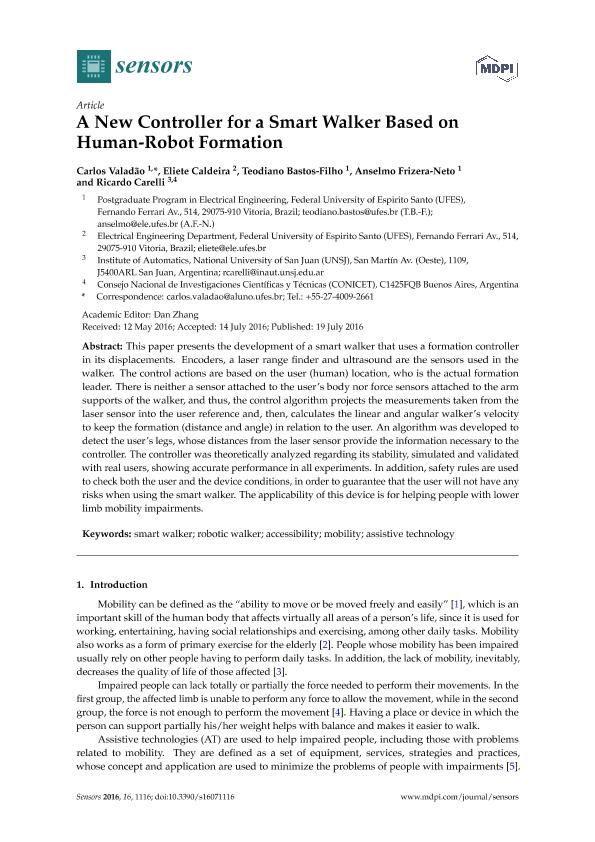Mostrar el registro sencillo del ítem
dc.contributor.author
Valadão, Carlos
dc.contributor.author
Caldeira, Eliete
dc.contributor.author
Bastos-Filho, Teodiano
dc.contributor.author
Frizera Neto, Anselmo
dc.contributor.author
Carelli Albarracin, Ricardo Oscar

dc.date.available
2018-09-27T20:59:19Z
dc.date.issued
2016-07
dc.identifier.citation
Valadão, Carlos; Caldeira, Eliete; Bastos-Filho, Teodiano; Frizera Neto, Anselmo; Carelli Albarracin, Ricardo Oscar; A new controller for a smart walker based on human-robot formation; Molecular Diversity Preservation International; Sensors; 16; 7; 7-2016; 1-26
dc.identifier.issn
1424-8220
dc.identifier.uri
http://hdl.handle.net/11336/61133
dc.description.abstract
This paper presents the development of a smart walker that uses a formation controller in its displacements. Encoders, a laser range finder and ultrasound are the sensors used in the walker. The control actions are based on the user (human) location, who is the actual formation leader. There is neither a sensor attached to the user’s body nor force sensors attached to the arm supports of the walker, and thus, the control algorithm projects the measurements taken from the laser sensor into the user reference and, then, calculates the linear and angular walker’s velocity to keep the formation (distance and angle) in relation to the user. An algorithm was developed to detect the user’s legs, whose distances from the laser sensor provide the information necessary to the controller. The controller was theoretically analyzed regarding its stability, simulated and validated with real users, showing accurate performance in all experiments. In addition, safety rules are used to check both the user and the device conditions, in order to guarantee that the user will not have any risks when using the smart walker. The applicability of this device is for helping people with lower limb mobility impairments.
dc.format
application/pdf
dc.language.iso
eng
dc.publisher
Molecular Diversity Preservation International

dc.rights
info:eu-repo/semantics/openAccess
dc.rights.uri
https://creativecommons.org/licenses/by-nc-sa/2.5/ar/
dc.subject
Accessibility
dc.subject
Assistive Technology
dc.subject
Mobility
dc.subject
Robotic Walker
dc.subject
Smart Walker
dc.subject.classification
Ingeniería de Sistemas y Comunicaciones

dc.subject.classification
Ingeniería Eléctrica, Ingeniería Electrónica e Ingeniería de la Información

dc.subject.classification
INGENIERÍAS Y TECNOLOGÍAS

dc.title
A new controller for a smart walker based on human-robot formation
dc.type
info:eu-repo/semantics/article
dc.type
info:ar-repo/semantics/artículo
dc.type
info:eu-repo/semantics/publishedVersion
dc.date.updated
2018-09-27T20:14:59Z
dc.journal.volume
16
dc.journal.number
7
dc.journal.pagination
1-26
dc.journal.pais
Suiza

dc.journal.ciudad
Basilea
dc.description.fil
Fil: Valadão, Carlos. Universidade Federal Do Espirito Santo. Centro Tecnológico; Brasil
dc.description.fil
Fil: Caldeira, Eliete. Universidade Federal Do Espirito Santo. Centro Tecnológico; Brasil
dc.description.fil
Fil: Bastos-Filho, Teodiano. Universidade Federal Do Espirito Santo. Centro Tecnológico; Brasil
dc.description.fil
Fil: Frizera Neto, Anselmo. Universidade Federal Do Espirito Santo. Centro Tecnológico; Brasil
dc.description.fil
Fil: Carelli Albarracin, Ricardo Oscar. Consejo Nacional de Investigaciones Científicas y Técnicas. Centro Científico Tecnológico Conicet - San Juan. Instituto de Automática. Universidad Nacional de San Juan. Facultad de Ingeniería. Instituto de Automática; Argentina
dc.journal.title
Sensors

dc.relation.alternativeid
info:eu-repo/semantics/altIdentifier/doi/http://dx.doi.org/10.3390/s16071116
dc.relation.alternativeid
info:eu-repo/semantics/altIdentifier/url/https://www.mdpi.com/1424-8220/16/7/1116
Archivos asociados
